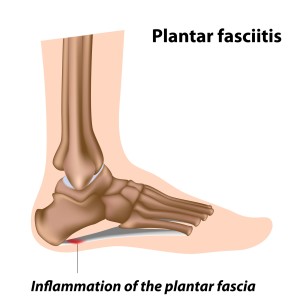Pain in Heel of Foot? It’s a Red Flag for Plantar Fasciitis
If you just typed "pain in heel of foot" into your web browser, you're likely looking for answers as to what causes---and what alleviates---plantar fasciitis, a condition sometimes caused by poor-fitting shoes or high heels.
Heel and foot pain is a common complaint that can be related to flat feet and arches that are very high, as well as to the type of footwear you tend to wear. Even though it’s common, you shouldn’t overlook or ignore heel or foot pain, since it can limit your mobility and prevent you from participating in your regular activities. What’s more, foot pain—including that “pain in heel of foot” you’re feeling—can result in the development of pain elsewhere in your body if it affects the way you hold yourself when you walk. The lower leg, knee, hip, and back, for example, may be affected; people with pain in these areas often need to have their foot health evaluated.
What Causes Heel Pain?
In addition to your foot type, two other culprits in foot pain and especially that pain in your heel are a sudden increase in activity and/or improper shoes (shoes that are not appropriate for whatever activity you are engaging in, or are too tight or too loose).
One of the first places an active person will experience pain is in the heel, which is under a lot of stress from repetitive loading. An active person’s foot makes contact with the ground 10,000 to 15,000 times in a single day, and this constant repetitive motion of the heel can take a toll. Two conditions that can develop from it are plantar fasciitis and Achilles tendonitis.
Plantar Fasciitis
This is inflammation in the plantar fascia, a band of tissue that runs the length of the bottom of the foot and links your toes to your heel bone. It is particularly common in runners, overweight and obese individuals, and people who are either flat-footed or have an unusually high arches.

The plantar fascia is a band of tissue extending along the bottom of your foot, from your heel bone to your toes.
Plantar fasciitis causes stabbing pain in the heel area after the foot has been at rest for some time (for example, pain in heel first thing in the morning), but as the foot limbers up, the pain decreases.
People with plantar fasciitis may adjust the way they walk in order to minimize their discomfort, and they can develop knee, hip or back problems if the condition affects their posture. They also may develop spurs of bone that may cause additional pain.
Treatment for plantar fasciitis includes physical therapy to stretch the plantar fascia, and taping to support the bottom of the foot. You also may be fitted for a night splint that holds the plantar fascia in a lengthened position while you sleep. Orthotics (special supportive inserts that fit in your shoes) can help distribute pressure more evenly along the sole of your foot, easing pain in heel.
Achilles Tendonitis
The Achilles tendon connects the calf muscles to the heel bone. It can become inflamed due to overuse (for example, if you suddenly increase certain activities, such as running), or from wearing the wrong type of shoes for whatever exercise you’re engaged in (one reason why it’s so important to wear good-quality running or walking shoes). It also can develop if you have flat feet, since this can exert stress on the Achilles tendon.
Achilles tendinitis can make the Achilles tendon vulnerable to tears, particularly if you are age 40 or older, since the blood supply to these connective tissues decreases significantly from middle age onward. When there is less blood supply, there is less elasticity, and even small tears in the tendons take longer to heal.
Preventing and Treating Pain in Heel of Foot
You can help prevent pain in heel by strengthening your feet, and regularly stretching the tendons and ligaments. Walking is one of the best strengthening exercises for feet because it puts a tremendous amount of stress and force on the foot. Also stretch your Achilles tendon in the morning before you get out of bed, since this also is good for the plantar fascia, and the posterior tibial tendon, which starts in your calf and travels down behind the inside of the ankles before linking to the middle of your foot.
Other pain-relieving strategies for pain in your heel include wearing prescription orthotics in areas where there are structural deficits (for example, orthotic inserts can help support flat arches).
Some find relief from over-the-counter medications; be aware, however, of warnings on labels. (See our post “Need a Pain Reliever?” for information on such options as nonsteroidal anti-inflammatory drugs [NSAIDs]. See also our post on natural pain relievers: “NSAID Side Effects Pose Serious Risks—Try Natural Pain Relievers Instead.”)
If you still don’t experience relief for your heel pain, an ultrasound-guided cortisone injection can help. Surgery should be considered only when all else fails and all conservative measures are exhausted.
Published in 2016 and regularly updated.


 Vestibular Migraine Diet
Vestibular Migraine Diet  Bone Spurs on the Spine
Bone Spurs on the Spine  Knee Injections for Osteoarthritis Pain Relief
Knee Injections for Osteoarthritis Pain Relief 
Obviously, certain footwear---especially poor-fitting shoes as well as (pictured) high-heeled shoes---frequently starts the pattern of pain in the heel of your foot.
© Dreamer82 | Dreamstime.com